|
The North American F-82/XP-82/P-82 "Twin" Mustang http://www.chariot.net.au/~theburfs/URmust.html The Twin Mustang was conceived in 1943 as an ultra long range escort fighter with accommodation for a relief pilot. During WW.2 the belief had developed that an escort fighter needed two engines and a crew of two. The P-51 itself disproved those assumptions when it escorted 8th AF bombers deep into Germany. However, the greater distances of the Pacific war, and the advent of the B-29 Superfortress bomber, revived the idea, with an expectation that fighter crews, like their bomber counterparts, might face six to eight hours in the cockpit.
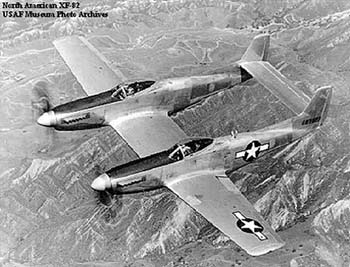 The F-82 'Twin Mustang' http://www3.freeweb.ne.jp/diary/kayshi
The proposal was to join two P-51H airframes by means of a constant-chord centre section and rectangular tailplane, retaining a port and starboard outer wing but deleting the remaining outer tail surfaces. The pilot, with full flight and engine instruments, occupied the port cockpit, and a co-pilot sat in the starboard cockpit with sufficient instruments to control the aircraft to relieve the pilot or in an emergency. The undercarriage was to consist of a single main wheel between each fuselage and the centre section, and twin tailwheels. Design work began in January 1944, and the first flight by one of the two prototypes designated XP-82 was on April 15, 1945. It was powered by two Packard Merlin V-1650-23/25 engines of 1,860 hp. By this time, 500 production aircraft, designated P-82B, were on order.
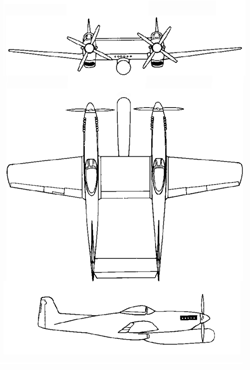 The F-82 'Twin Mustang' 3view
These were essentially similar to the prototypes, but had wing racks for four 1,000 lb (453.5 kg) or two 2,000 lb (907 kg) bombs, twenty-five 5-in (12.7 cm) rockets, or a central pod supplementing the six inbuilt .5 in (12.7mm) machine guns with a further eight similar weapons. The third prototype differed in having Allison V-1710-119 engines with airscrews rotating in the same direction. The end of the Pacific war saw a cut-back in production orders of the P-82B to twenty aircraft. One of these, Betty Jo, establishing a number of distance records, including a non-stop flight between Honolulu and New York on 28th February, 1947, in 14 hours and 32 minutes. This stood into the 1990s as the longest unrefuelled flight by a piston-engined fighter. Two of this batch were completed as night-fighters; a P-82C (with SCR-720 airborne intercept radar) and a P-82D (with APS-4 radar).
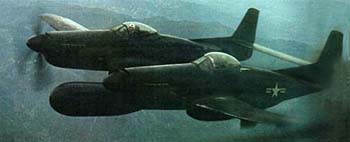
An F-82G Twin Mustang of the USAF's 68th All-Weather Squadron based at Itazuke, Japan, returns from a weather reconnaissance mission over North Korea. http://www.chariot.net.au/~theburfs/URmust.html
The radar was housed in a large nacelle under the wing centre section. Other equipment included an APN-1 radar altimeter and APS-13 tail warning. The starboard cockpit was adapted to house the radar operator. In 1947, orders were placed for 250 additional Twin Mustangs, the first 100 to be P-82E (later designated F-82E) day fighters, for escort and ground attack, and the remainder to be night-fighters. These would comprise 91 P-82Fs with APS-4 radar, and 59 P-82-Gs with SCR-720 radar. All three versions would be powered by the Allison V-1710-143/145 engines. From June 1948 all three types were redesignated F-82E, F-82F and F-82G. The F-82E served as a long-range escort with Strategic Air Command between 1948 and 1950. The Twin Mustang entered service with the USAF's Air Defense Command, succeeding the P-61 Black Widow, and was subsequently deployed overseas with the 5th Air Force in Japan, operating over Korea in the early stages of the Korean War. An F-82G of the 68th (All-Weather) Squadron was credited with the destruction of the first enemy aircraft on June 27th, 1950. After withdrawal from service in the Far East Air Force, fourteen F-82F and F-82G Twin Mustangs were winterised, redesignated F-82H, and assigned to Alaska. Only five Twin Mustangs are known to have survived into the 1990s, none of them airworthy. The Confederate Air Force at Midland, Texas, undertook restoration of a P-82D to flying condition, delayed somewhat as they sought a left-handed propellor. North American F-82E data:
The North American P-82 Twin Mustang http://www.webtownis.bc.ca/modelcraft/mustang.html The North American P-82 Twin Mustang was the last version in the evolution of the Mustang design, and was developed to satisfy the requirement for a long range escort fighter to accompany bombers to targets in Japan. The design concept began with the idea of mating two Mustang fuselages to a constant chord wing center section housing the six 0.50 in. machine gun armament, and a one piece horizontal stabilizer, also of constant chord. The fuselages were from the lightweight XP-51F design, lengthened 57 in. for greater directional stability. The two XP-82 aircraft were equipped with standard P-51H tail sections, but production aircraft featured wider vertical stabilizer units and enlarged dorsal fin fillets. The outer wing panels, with armament remover, contained fuel tanks, as did the center section. The main landing gear, located under each fuselage, retracted inwards, and was housed in the center section. The tailwheels were standard P51 units, retracting into the aft fuselage. The XP-82 was powered by uprated Packard Merlin V-1650=11 and -21 engines driving opposite rotating inward turning propellers, to counter the torque. Both cockpits featured flight controls, but only the left cockpit had full instrumentation. The first flight of the XP-82 took place on 15 April 1945, and the flight tests revealed a performance equaling the P-51D variant, with a longer operational range. An order, based on the proposal, had been placed in March 1944 for 500 P-82 aircraft , a year before the flight of the XP-82. When, with the end of WWII approaching, it became apparent that production would not begin before then, the order was cut to include two of the four prototypes, and 20 aircraft , 18 P-82B and one each of the XP-82C and Xp-82D The P-82E was the first variant to be powered by the Allison V-1710 engine which had been intended for the canceled P-82A. The Allison engine had been earmarked for future production in order to avoid purchasing Merlin engines from Rolls Royce in England when Packard stated its intentions to cease production of aircraft engines in favour of resuming production of automobiles. New contracts issued postwar for 250 P-82 aircraft included 100 P-82E ordered on 12 December 1945. This version was projected as an extra long range escort fighter and fighter bomber. A centrally mounted gun pod was proposed, but was never put in production. Nevertheless, various combinations of ordnance were carried as well as drop tanks to extend range. Due to problems with the Allison engines, production was delayed, setting back deliveries from a proposed start date of March 1946 to April 1947. By the end of 1947, on 4 aircraft had been delivered, but by March 1948 the 27th Fighter Escort Group of the USAF began receiving aircraft , and by the end of 1948 the 522nd, 523rd and 524th Squadrons had been equipped. Since the Cold War had by then begun, the 27th Fighter Escort Group directed its training toward the possibility of escorting B-29s, and later B-50 and B-36 bombers to potential targets in the Soviet Union. The service life of the F-82 was limited, for by 1950, the Strategic Air Command had no further use for the propeller driven long range fighter escort, and the F-82E was replaced by the F-84E Thunderjet in the 27th Fighter Escort Group.
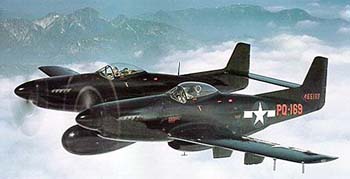 citation tba
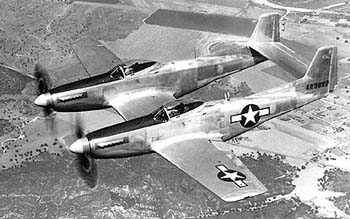 citation tba
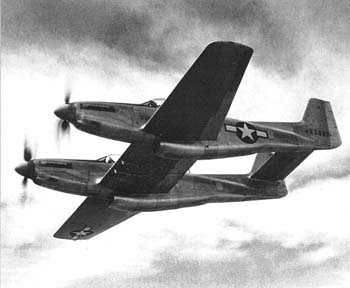 citation tba
|